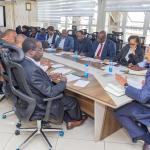Automated Fare Collection System (AFCS) Inter-Agency Committee Inaugural Meeting
The Ministry of Roads and Transport today, convened the inaugural meeting of the Inter-Agency Technical Committee that will spearhead the development of a Kenya Integrated Automated Fare Collection System (AFCS). The AFCS is envisioned to offer a one stop shop for fare collection for the consumer across that will enable seamless intermodal transportation across the different modes of transport such as Commuter Rail, Matatu and Bus Rapid Transit (BRT).
The AFCS is a key component under the Kenya Urban Mobility Improvement Project (KUMIP) that aims to improve urban mobility in Nairobi Metropolitan Area (NMA) and enhance institutional strengthening and capacity building.
The meeting, held at Transcom House, brought together members of the committee derived from a diverse group of stakeholders in Kenya’s transport and urban mobility sector including: State Department for Transport, State Department for Roads, Federation of Public Transport Operators, National Transport and Safety Authority (NTSA), Kenya Railways Corporation (KRC), Nairobi Metropolitan Area Transport Authority (NaMATA), Kenya Private Sector Alliance (KEPSA), Council of Governors, Nairobi City County Government, Kiambu County Government, the National Treasury, State Department for ICT and the Digital Economy, Kenya Revenue Authority (KRA), and the Central Bank of Kenya.
The meeting, chaired by the Secretary - Transport Policy, Planning, Finance and Coordination of State Corporations at the State Department for Transport, Dr. Duncan Hunda deliberated on the action plan and strategies towards development of a framework of national standards and business rules for the Automated Fare Collection System, as well as the institutional and infrastructural setup that will support implementation of the system.
The AFCS is part of the government's commitment to improving public transport as part of broader efforts to promote sustainable urban mobility and economic growth which will reduce operational costs, increase transparency, and enhance convenience for all commuters.






